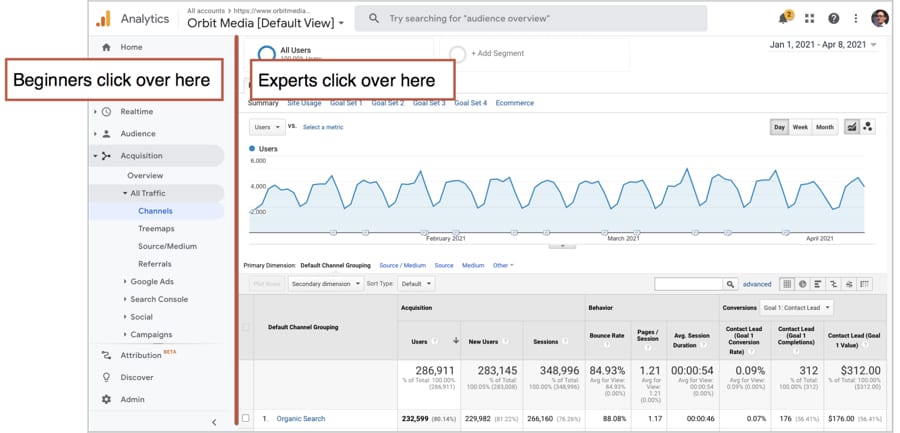A Complete Guide to Comprehending When Does the Google Analytics Tracking Code Send an Event Hit to Analytics
A Complete Guide to Comprehending When Does the Google Analytics Tracking Code Send an Event Hit to Analytics
Blog Article
Enhance Your Search Engine Optimization Strategy With Effective Google Analytics Monitoring Code
Incorporating Google Analytics tracking code right into your SEO method is a pivotal action towards accomplishing quantifiable results. Correct implementation not just provides a clear home window into individual actions and web traffic resources but likewise highlights critical performance indications that can inform your material approach. By understanding metrics such as organic website traffic and conversion rates, you can identify locations for optimization. Nonetheless, truth prospective hinge on how these insights can be leveraged to fine-tune your strategy. What specific methods can you take on to optimize the influence of this data on your SEO efforts?

Understanding Google Analytics Essentials
To successfully leverage Google Analytics for Search Engine Optimization, it is important to understand its fundamental ideas. Google Analytics offers as a powerful device for tracking and analyzing web site traffic, supplying insights that are essential for enhancing internet search engine performance. At its core, the platform enables individuals to monitor customer behavior, traffic sources, and key performance indicators (KPIs) such as bounce prices and session durations.
Experience with the customer interface is essential. The Target market section offers market insights, assisting to customize web content to target customers effectively.
Understanding metrics such as organic traffic volumes and conversion rates is vital for reviewing search engine optimization performance. Inevitably, understanding these essentials permits electronic marketing professionals to harness the complete capacity of Google Analytics, driving notified decisions that enhance overall search engine optimization strategies. By establishing a strong structure, organizations can properly examine their efficiency and determine chances for improvement in their online presence.
Establishing Monitoring Code
Appropriately setting up the tracking code is crucial for accurate information collection in Google Analytics. The initial step includes creating a Google Analytics account and residential or commercial property, where you will obtain a special tracking ID. This ID is important for connecting your web site's data to your Google Analytics account.
Once you have your monitoring ID, integrate the monitoring code fragment into your website's HTML. This is commonly put in the header section of each web page to ensure it loads early in the web page providing procedure. If you're making use of a Material Management System (CMS) like WordPress, many plugins streamline this procedure, allowing you to include the tracking code without straight HTML modifying.
After implementing the monitoring code, it is vital to examine its performance. If the tracking code is properly mounted and working, you can make use of the Google Tag Aide device to confirm. In addition, keep track of the real-time coverage feature in Google Analytics to validate that data is being gathered appropriately.
Guaranteeing that the monitoring code is properly established lays the structure for effective information evaluation, enabling you to make educated choices to enhance your SEO method and total site efficiency.
Trick Metrics to Monitor
Determining vital metrics to monitor is vital for recognizing the effectiveness of your SEO method via Google Analytics. By concentrating on specific data points, you can assess the influence of your optimization initiatives and make informed decisions to improve performance.
Among the key metrics to track is natural website traffic, which indicates the number of visitors reaching your site with internet search engine. This statistics mirrors the total health of your SEO strategy. Next, keep track of the bounce rate, which shows the percentage of visitors who leave your site after viewing only one web page. A high bounce price might signify that your web content is not fulfilling customer assumptions or that your touchdown pages need improvement.
Additionally, take into consideration tracking conversion prices, as these metrics expose exactly how well your site satisfies its company purposes, such as generating leads or sales. Key words positions are also important; tracking changes in keyword placements aids examine the effectiveness of your targeted SEO initiatives. Lastly, assess the ordinary session period, which indicates customer interaction and content importance. By carefully following these vital metrics, you can get important understandings right into your SEO approach's performance and identify locations for improvement.
Analyzing Customer Behavior
Recognizing user habits is critical for refining your search engine optimization approach and making best use of site efficiency. when does the google analytics tracking code send an event hit to analytics?. By analyzing how site visitors interact with your site, you can discover beneficial insights that notify your material and layout decisions. Google Analytics offers a wide range of information on user engagement metrics, such as bounce prices, time on website, and web page sights per session. These metrics help identify which pages resonate with your target market and which might call for optimization.
Furthermore, tracking individual circulation can expose typical navigating courses, highlighting prospective traffic jams or reference areas for enhancement. Comprehending the demographics, rate of interests, and geographic places of your visitors permits more tailored content that speaks with their needs. Utilizing division attributes in Google Analytics additionally improves your capability to evaluate user behavior by permitting you to contrast various audience groups.
Moreover, monitoring conversion prices and customer activities can offer insights right into the performance of your phone call to action and overall website layout. This alternative view of customer habits is necessary for making notified decisions that boost individual experience and drive higher engagement, inevitably contributing to improved search engine optimization performance.
Leveraging Insights for Search Engine Optimization
Constantly leveraging insights gained from customer behavior evaluation can substantially improve your SEO initiatives. By using Google Analytics, you can identify crucial metrics such as bounce rates, session period, and customer flow, which disclose exactly how visitors connect with your material. These insights allow you to identify locations needing improvement, such as high leave pages or underperforming key words.

Furthermore, tracking natural web traffic sources offers clarity on which channels are most effective, allowing you to allocate sources tactically (when does the google analytics tracking code send an event hit to analytics?). By analyzing conversion prices along with web traffic data, you can identify which basics web pages drive real company results, refining your search engine optimization method even more
Incorporating these understandings into your content approach not only enhances presence however also cultivates a much more user-centric approach. Inevitably, a data-driven search engine optimization strategy educated by analytics not only enhances rankings but additionally aligns your purposes with individual assumptions, causing sustained development and engagement.
Verdict
Efficient application of Google Analytics tracking code dramatically boosts a Search engine optimization strategy by providing essential insights into user behavior and traffic sources. Ultimately, leveraging these insights contributes to refining Search engine optimization initiatives, driving even more pertinent website traffic, and boosting general web site performance.
Integrating Google Analytics tracking code into your SEO strategy is a pivotal action towards accomplishing measurable results. At its core, the system makes it possible for customers to keep an eye on individual behavior, best site traffic resources, and vital efficiency indicators (KPIs) such as bounce rates and session periods.
Recognizing individual behavior is crucial for improving your Search engine optimization technique and optimizing site efficiency.Regularly leveraging insights gained from customer habits analysis can dramatically boost your Search engine optimization initiatives.Efficient application of Google Analytics tracking code substantially improves a SEO strategy by giving essential insights right into user behavior and traffic resources.
Report this page